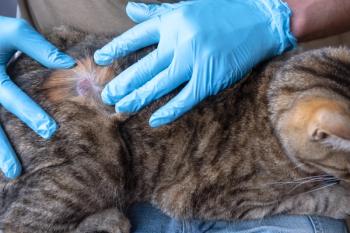
Veterinary team members: Open the door to practice ownership
Three veterinary team members who are or have been part-owners reveal the challenges, benefits, and strategies for making it work.
Ask veterinary experts about the most pressing issues facing the veterinary profession, and some will give you these answers: a lack of associate doctors interested in owning practices and a lack of professional advancement opportunities for veterinary team members. There’s one solution that could possibly solve both of these issues: Non-veterinarians like you becoming part-owners of veterinary practices.
In the past, the climb to practice ownership may have seemed too steep for non-veterinarians. But changing state laws-though complex, fluid, and far from universal-are leveling the playing field for managers and technicians.
As the following stories of three veterinary team members suggest, practice ownership comes with debt, stress, and increased responsibility. But the financial rewards can be long term and knowing you’re building something that’s your own, something for the next generation, just might fulfill a dream.
Associates aren’t looking to own
Here’s your chance to get a foot in the door of practice ownership. The number of associate veterinarians interested in one day owning a veterinary practice is decreasing.
Without being overly dramatic, the decrease could significantly impact the profession, say some industry experts. What’s the solution? Opinions vary, but one idea is that veterinary team members might step up to become practice owners. The data below hints that non-veterinarian ownership could become more common soon.
Read on for three team members' tales of practice ownership ...
Story 1: Ownership became a family calling
When Jim Nash, MPH, CVPM, talks about the Community Pet Hospital satellite facilities in Firestone and Riverdale, Colo., that he owns with two veterinarian partners, he keeps coming back to the word legacy. He hungered for a role in veterinary medicine that would allow him to build something bigger than himself.
“We affect the lives of people and their pets every day. As an owner, I can be part of creating something that goes beyond my time,” Nash says. “To me, that would be a tremendous success-to be a good steward and to leave something valuable behind.”
Nash channeled these thoughts into what he calls “ownership thinking.” He and his wife wanted an investment that would provide long term for their family without requiring 50- to 60-hour work weeks until age 65. “We decided practice ownership would be worth the risk,” Nash says. “When you aren’t an owner, you’re putting into someone else’s future, not your own.”
The decision, he says, was like a decision to wed. After a year at Community Pet Hospital, where he found like minds with a willingness to change, he knew he wanted to tie the knot. At his annual review with the two partners he expressed an interest in owning should the opportunity arise. Two years later, it did.
When the hospital added 24-hour emergency service, the extra caseload put a strain on space. The partners were interested in starting a pair of satellite facilities to complement the small animal and emergency care they already offered. They created a separate business entity to own the satellite facilities and invited Nash to be an equal partner in them. His one-third stake satisfied Colorado law, which prohibits a non-veterinarian from owning more than 49 percent of a practice.
The transaction and transition were relatively easy, Nash says. “We had established mutual trust and respect. They had seen what I wanted to do and what I could do,” he says. “We knew what we wanted to accomplish and it was just a question of how to get there together. Day-to-day, my commitment didn’t change. We were all sure we wanted to get married, and we did.”
Read on for Nash's tips for potential non-DVM practice owners ...
Nash’s tips for potential non-DVM practice owners
1. Be ready for major commitment. Ownership is a 24-hour-a-day job, Nash says. You might be in the middle of grocery shopping, as he was in early June, and get a call from the police telling you the alarm is sounding at your practice. You’ll need to be willing to drop everything to respond. “A lot of practice managers have embraced a higher level of responsibility,” he says, “but as an owner, the practice is always on your mind. You’re always wondering, ‘Is everything OK?’”
2. Prepare to care-deeply. Be ready for a heightened sense of responsibility for the people and their families who work for you, Nash says. Here’s an example: A decision you make about whether to offer employees health care will not only impact your team members but also their children. Nash felt compelled to take care of the team as a practice manager, but being an owner was a level of accountability he hadn’t imagined. Community Pet Hospital went from 16 employees when Nash started to 50 team members today. “Think about it,” he says, “that’s 34 jobs we’ve created in this community.”
3. Plan a business wedding. “Find partners you want to marry,” Nash says. How? By looking for partners who hold values similar to yours. “I’m speaking of personal beliefs, morals, ethics, philosophies,” Nash explains, adding he is less concerned about business values. “You can disagree about policies and procedures if you share the value of accountability and conflict resolution. These core values will be the guiding principles of your partnership and of your practice. Sharing the philosophy of caring about your employees and recognizing your obligation to them is much more important than agreeing on an attendance policy.”
4. Think like an owner first. Two ways to do this: Look at the practice from a process and flow point of view. Analyze how both could be improved. Also learn all you can about team building, because creating a strong, unified team is vital to success, Nash says.
Read on for Jennifer Keefe's story, a practice "marriage" that ended in divorce ...
Story 2: It’s a marriage, rocky at times
Veterinary technician Jennifer Keefe also describes ownership as a marriage, and hers ended in divorce. Despite working with her veterinarian business partner at two practices before starting their own, Keefe left her practice Aug. 1, just one year after the opening.
The idea of opening a clinic hatched three and a half years ago when the veterinarian approached Keefe at the practice where they worked and said, “We could do this better.” At the time, non-veterinarians couldn’t be equal partners in a veterinary practice in New Hampshire but the law changed and the pieces fell into place quickly. Keefe, CVT, VTS, (ECC, Anesthesia), and the veterinarian had already identified team members who’d work at their practice. Keefe and her business partner were eager and they shared one philosophy Keefe still thinks is crucial: “Always, the patients come first with us. They come before anyone else.”
But this mutual focus wasn’t enough. “You don’t know someone well until you go into business with them,” Keefe says. “We were friends. Our families were friendly. We hung out with each other after work… When it comes to owning a business, we found a whole different dynamic.”
Part of that dynamic was the tension of a non-doctor in a decision-making position. “If you’re not a veterinarian, you’re in a tough spot,” she explains. “When you own a practice, there’s always someone afraid you’ll dictate medicine.”
This was a tightrope for Keefe. “As a technician on shift, I had more freedom to make medical suggestions and decisions than I did as an owner,” she says. Why? Part of the requirement in New Hampshire and other states is that non-veterinarian owners play no part in medicine. The provision is intended to prevent a corporate, profit-focused entity from influencing a veterinarian’s judgment. In short, the rule tries to ensure that the bottom line doesn’t control the medicine or medical ethics.
One of Keefe’s top suggestions to non-veterinarians who want to own practices is to clearly delineate medical decisions from non-medical ones. In fact, if you live in a state that prohibits non-veterinarians from owning veterinary practices, doing so will likely be a requirement. (For more about this, see
Despite these challenges and leaving ownership, Keefe is still upbeat about the opportunity for non-veterinarians to be owners. “I could not be prouder of the practice we built,” she says. “And I could not have been happier with our staff. The most important thing for us was to treat the patient in front of us. Sometimes when you’re working for someone else, that’s hard. If you have a hit-by-car come in, for example, some places won’t let you give the patient medical treatment until you know the client has money.
“Putting the patient first was stellar for us,” Keefe says. “That’s one reason I’m bummed about leaving the practice. No matter what, the patients came first. What a cool profession we have. And now we can even own a practice. But you don’t want to go into ownership lightly.”
Read on for Keefe's tips for potential non-DVM practice owners ...
Keefe’s tips for potential non-DVM practice owners
1. Prepare for debt. Building a start-up practice isn’t easy and you’ll probably wind up knocking on a lot of doors looking for funds. Keefe and her veterinarian business partner met financial hurdle after hurdle, from demands for infusions of cash to holding the first year’s loan interest in escrow. “Don’t think that just because you think it is a good idea, they will, too,” Keefe cautions.
2. Define roles. Keefe’s situation was less straightforward because she’s a technician rather than a manager. To try to help, she and the doctor divided managerial duties; her partner handled bookkeeping and Keefe took on human resources. “In hindsight, we should have defined our roles better,” Keefe says.
3. Insist on staff input. “Even though you tell people you want a lot of feedback-we said, ‘We’re new at this; we need to know’-people don’t always speak up,” she says. “We had to have a big meeting early on about gossip-with just eight employees.”
4. Support your partner-and vice versa. “Two owners will be like a mom and a dad,” Keefe says. “They need to have solid trust and to back each other. If they don’t, they lose authority.”
Read on for Marianne Mallonee's story, who talked her future partners into a new exit strategy: her ...
Story 3: A gut-level desire realized
Marianne Mallonee shoulders the responsibility of being an owner and hospital administrator at Wheat Ridge Animal Hospital in Wheat Ridge, Colo., during an economy that's tougher than usual. But her passion for veterinary practice ownership and management-as well as the great views of the Rocky Mountains-make the struggle worthwhile. “I had for years wanted to live in Colorado,” Mallonee says. “I also wanted to be a practice owner. It was a lucky plus the two go hand-in-hand here.”
One reason Mallonee moved to Colorado from Atlanta, where she got her first management job, is because the state allows non-veterinarians to own up to 49 percent of a practice.
“I had a gut feeling owning a veterinary practice was something I wanted to do,” she says. “Even prior to Atlanta, way back in college, being an owner was just something I wanted to do.”
The ownership opportunity presented itself three years ago while Mallonee was in a Wheat Ridge board meeting. The partners were discussing an exit strategy and making a list of associates who might be interested in ownership. The list wasn't long and her name wasn't on it. “I raised my hand and said, ‘You have an exit strategy sitting right here at the table with you,'” Mallonee says.
Being an owner has proved different from being an employee. Mallonee says ownership gave her a different sense of pride in the practice: “When you're an owner, you know that come hell or high water you were there and you were responsible for making a difference.”
The level of responsibility she feels, though, hasn't changed much. The administrator's job, she says, is to function as an owner, put in long hours with the team, and worry over hospital success. When the owners invited her to be a partner they said, “You're treating this practice as if it were your own; now let's make it your own.”
What about the lure of financial reward? “From a long-term perspective,” she says, “the practice becomes an asset, an important piece of my future. But the financial side was not a deciding factor. In fact, the financial side, right now, is one of the drawbacks.”
She says potential owners must consider the risks. Her 56-year-old practice-a high-tech 24-hour hospital with four partners, 20 doctors, and 100 employees-is hurting, she says, in the current economy and she's struggling with debt. She became a partner in 2008, which wasn't the best time to take on debt, and her portion of the practice is worth less now than what she owes on it. “I know that this was the right decision in the long run, but currently I‘m feeling a huge financial pinch,” Mallonee says.
The other challenge, she says, is inevitable: “No matter how hard you try, you are now ‘one of them.' I used to call the owners ‘the partners.' Now I have to stop myself and think, ‘Wait, I am a partner.'” Still, she says she's maintained a solid relationship with staff members and can now help serve as a link between them and the shareholders.
Happily, Mallonee's biggest fear has not come to pass. She worried that, in creating a long-term relationship, she'd become bored with the practice. Instead, she's embraced the certainty. “I'm going to make a difference the next 20-plus years,” she says. “I feel I'm in the right place. I know I made the right decision.”
Read on for Mallonee's tips for non-DVM practice owners ...
Mallonee’s tips for potential non-DVM practice owners
1. Assume the role. Mallonee says one of the reasons the partners were comfortable bringing her into the fold was because she was already functioning with the mindset of an owner.
2. Speak up. As a non-veterinarian, you may have to suggest your value as a partner to the owners. “They may not intuitively think of you,” she says.
3. Be patient. While Mallonee encourages you to broach the subject of ownership, she thinks you should wait three to five years before you bring it up with the current owners. It is deadly, she says, to bring the subject up on the day you interview for the job.
4. Settle down. Make sure you want a long-term commitment before buying in, Mallonee says. She has asked herself several times whether she will grow bored working in the same practice forever. The answer, which she keeps coming back to: “No matter how good we are, we can always be better… I’m going to make a difference across the next 20 years and I feel I’m in the right place to do it.”
Could ownership be the right decision for you? Perhaps. Becoming an owner takes planning and will likely require you to hire an attorney to help you through the complex process. But slogging through the paperwork and legal hurdles might be the best thing you do for yourself-and the profession overall.
Newsletter
From exam room tips to practice management insights, get trusted veterinary news delivered straight to your inbox—subscribe to dvm360.




